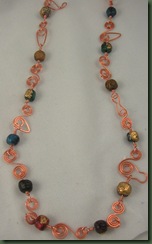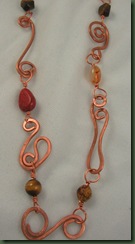Working on another chain project today, I kept asking myself “how many ways” can you curl the wire to make links? This phrase came from my mouth hundreds of times as a teacher, professor, and consultant trying to get others to think creatively. The question is basic to both fluent and flexible thinking. When working on creative fluency, we try to come up with as many answers as possible to the problem posed, in this case the straight piece of wire that needed to curl. During the fluency stage of problem solving, it doesn’t matter whether or not the posed solution is plausible or far fetched. The goal is simply to produce as many ideas as we can. Since I didn’t want my chain necklace to look uniform or to have a pattern, I continually asked how many ways I could produce the links.  Once I had completed the links, I then asked which ones could actually be used and eliminated the others. This is one of the judgment stages of problem solving when convergent thinking is required. If we judge too soon, however, often good adaptable ideas are thrown out without being given a chance to develop.
Once I had completed the links, I then asked which ones could actually be used and eliminated the others. This is one of the judgment stages of problem solving when convergent thinking is required. If we judge too soon, however, often good adaptable ideas are thrown out without being given a chance to develop.
The top link in this first photo is the regular S shape common in wire work. The middle link ended as an S, but began in another shape and the bird shape at the end happened accidentally. I used variations of these shapes through the rest of the necklace as shown in the picture of the entire necklace. I needed some good flexible thinking to make variations in the bird shape and you can see that some have upturned tail feathers while others are plain. The beads on this piece are also interesting. The vendor who sold them to me said they were made by Monks. They appear to be some type of clay.
to make variations in the bird shape and you can see that some have upturned tail feathers while others are plain. The beads on this piece are also interesting. The vendor who sold them to me said they were made by Monks. They appear to be some type of clay.
The lower picture shows a different necklace with more variations on the shapes of the links. It has various shaped coral, tiger eye, or carnelian gemstones in some of the links. This necklace is made of heavier, recycled wire while the necklace in the upper pictures is made of 18 and 20 gauge wire. If you make any of these, I suggest doing it in stages. I made most of the links in one day and my sore hands are not at all happy. That said, the fluency stage should happen all at once due to the natural production of ideas. Usually, there is a burst of ideas in the beginning (often the most common solutions), followed by a brief slow down and then the production of the most unique ideas. You wouldn’t want to quit right before those great ideas hatch!
